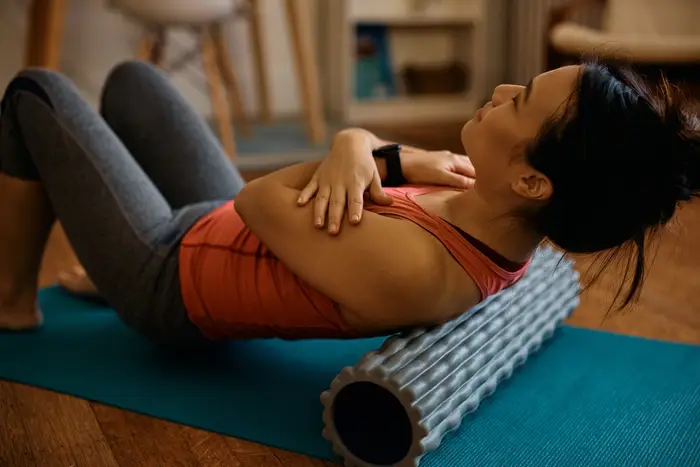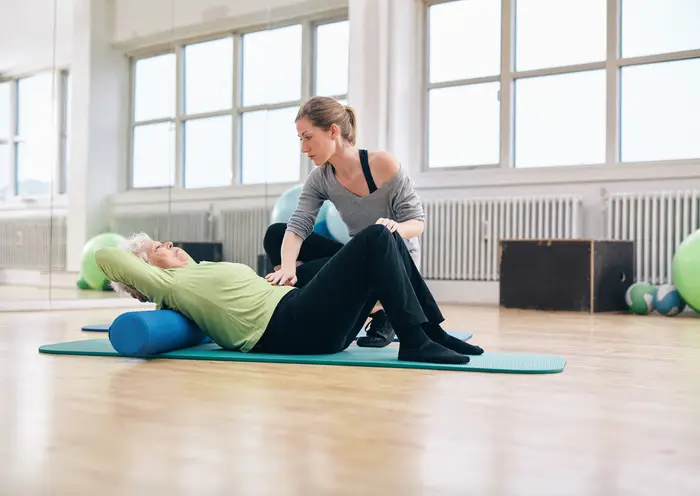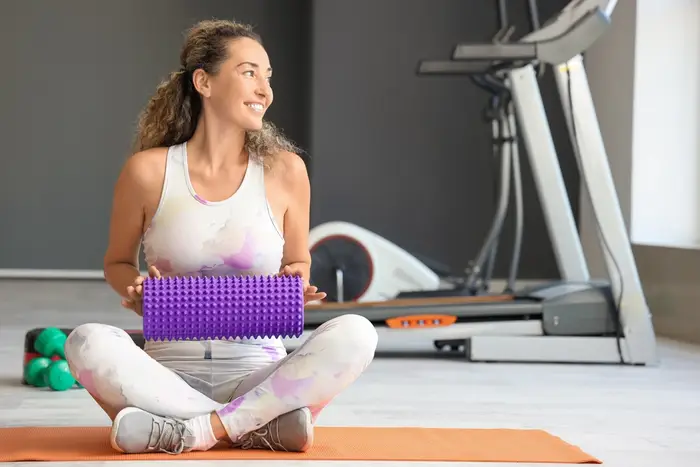Foam Roller for Back Pain Relief: Techniques, Benefits, and Best Practices
What is a Foam Roller?
A foam roller is a cylindrical piece of workout equipment meant to help release muscle tension, improve mobility, and assist in recuperation. Originally introduced in the late 20th century, foam rollers have grown rather popular in health and exercise regimens. Mainstays these days are home fitness programs, physiotherapy offices, and gyms.
Foam rollers are flexible and offer benefits from self-myofascial release (SMR) to more flexibility. Applied gently to specific areas, gentle pressure targets tight muscles and fascia, therefore generating a deep tissue massage effect.
Why Focus on the Back?
Our daily life depends considerably on back health, which influences posture and mobility among other aspects. Sadly, many people suffer from back-related issues including lower back soreness, poor posture, and stiffness brought on by inactive lives. Including foam roller for back in your program will aid with spine health, address problems, and improve general quality of living.
Benefits of Using a Foam Roller for the Back
Pain Relief and Muscle Relaxation
Foose rollers are great tools for releasing knots and back strain. Pressing trigger points releases fascia and tight muscles, therefore reducing pain and stiffness. Studies show that foam rolling helps to relieve ongoing back pain and promotes general relaxation.
Deep tissue massage effects of foam rolling set mechanoreceptors in the brain to signal muscles to relax. This method helps to reduce muscular spasms and gives relief.
Improved Flexibility and Mobility
Regular foam rolling stretches and lengthens tight muscles, hence increasing flexibility. Particularly with the back, limiting mobility can lead to poor posture and discomfort. Rolling the lumbar and thoracic sections maintains spine health and helps to keep the range of motion of surrounding joints.
Enhancing Blood Flow and Recovery
Rolling foam increases blood flow, thereby allowing muscles’ supply of nutrients and oxygen. Improved blood flow speeds up healing after exercise and reduces muscular pain. Foam rolling also aids lactic acid build-up be eliminated, therefore hastening recovery and reducing weariness.
Cost-Effective and Accessible Solution
A fairly cost and useful replacement for professional massages are fozen rollers. One can carry these flexible tools at home, in the gym, or even on a travel. They so make a reasonable addition to every self-care routine.

Types of Foam Rollers for Back Use
Different Materials and Densities
The several materials and densities of foam rollers satisfy various needs and tastes. Since soft foam rollers give little pressure, beginners or those with sensitive muscles would find them ideal. Conversely, firm rollers are suitable for experienced users or those seeking great physical release since they generate deeper pressure.
EVA foam and high-density foam are well-known materials with longevity and constant performance. Textured foam rollers with their ridges or spikes provide concentrated relief for specific areas.
Specialized Foam Rollers for Back Relief
Particularly designed for back use are some foam rolls including half-round rollers, vibrating rollers, and grid rollers. Giving precise relief, grid rollers feel like the hands of a massage professional. In vibrating foam rollers, combining pressure with vibration produces still another degree of relaxation. Half-round rollers provide consistency especially for beginners.
Choosing the Right Foam Roller for Your Needs
The foam roller you choose will depend on your size, firmness, and specific aims. Often a great starting point for beginners is a medium-density roller. Athletes seeking deeper muscle penetration would choose heavier or textured rollers; people with chronic pain could find gentler options helpful.
How to Use a Foam Roller for Back Pain Relief
Proper Techniques and Safety Tips
Maximizing advantages and avoiding damage depend on safe and efficient use of a foam roller. Use these exact instructions for best foam rolling:
- Lay the foam roller on a level, solid surface. Ground yourself and orient the roller across your back. Until your upper back makes contact, slowly slink back onto the roller.
- Start at the top of your shoulders then roll down to the middle of your back using upper back technique. Focusing on the muscles along either side of the spine helps you avoid directly pressing the spine.
- Targeting the lower back, gently move your weight to one side to concentrate on the erector spinae muscles rather than rolling straight over the lumbar vertebrae.
- Deep, under control breathing should be used all through the procedure. This promotes relaxation and helps to lower muscular tension.
- Keep your core active to stay steady; move slowly to let the roller target every muscle group with efficiency.
Common Mistakes to Avoid
- Rolling too quickly will lessen effectiveness. Spend some time making sure tight sections are under enough strain.
- Avoid overloading delicate areas since this could lead to bruising or discomfort.
- Roll always along the sides of the spine, not straight on the spine.
- Skipping Warm-Up: Before foam rolling, gently warm-up to release tensions.
Recommended Exercises for the Back
Here are some targeted foam rolling exercises to relieve back pain:
- Lie with the roller under your upper back, then slowly roll from your shoulder blades to the middle of your back using your hands behind your head. This releases stiffness in the thoracic area.
- Lie on your side with the foam roller beneath your armpit. Emphasizing the latissmus dorsi muscles, slowly roll along your body’s side.
- Lay the foam roller horizontally under your upper back for a thoracic extension stretch. Keeping your hands behind your head, gently arch backward over the roller, stopping momentarily to elongate the thoracic spine.
- Tilt somewhat to one side and roll along the muscles right above your hips. Lower Back Oblique Roll. This approach works for other supporting muscles as well as the quadratus lumborum.
Duration and Frequency
Give foam rolling sessions ten to twenty minutes for best effects. Spend one to two minutes on every targeted location, paying very close attention to any rather tight areas. Roll foam three to five times a week, particularly following extended stretches of sitting or after exercise. Long-term relief and good back health need commitment.
Foam Roller Use Cases and Success Stories
Real-Life Examples of Back Pain Relief
Many users say that using foam rolling in their program significantly helps with back pain. Athletes, office workers, and senior citizens have all related success stories of less suffering, greater freedom, and higher quality of life.
Who Can Benefit?
Many various individuals benefit from foam rolling, including:
- Participants: fights against injuries and encourages recuperation.
- Office workers lessen the strain of prolonged sitting.
- Seniors: reduces chronic pain and increases mobility.

Risks and Precautions
Who Should Avoid Foam Rolling?
Though most of the time safe, not every individual would be fit for foam rolling. Anyone with fractures, severe back trouble, or several diseases should visit a healthcare provider before using a foam roller.
Common Mistakes and How to Avoid Them
To ensure safe and effective foam rolling, avoid these common mistakes:
- Straight on the spine.
- Pressing delicate parts too forcefully.
- Skipping warm-ups prior to foam rolling.
When to Seek Professional Help
See a physical therapist or doctor if back discomfort continues even with foam rolling or if you have intense or increasing pain.
Best Practices for Integrating Foam Rolling into Your Routine
Combining Foam Rolling with Other Therapies
Combining foam rolling with other therapies like yoga, chiropractic treatment, or stretching will help it be most beneficial. These complimentary techniques improve general back condition and offer a complete approach to wellness.
Building a Sustainable Self-Care Routine
Getting the advantages from foam rolling depends on consistency. To keep long-term back health, include it into your daily schedule together with other wellness practices including appropriate water, consistent exercise, and a balanced diet.

Conclusion: Foam Roller for Back
Promoting back health is much enhanced by foam rollers, which also provide advantages including speedier recovery, pain alleviation, and more flexibility. Their adaptability, low cost, and simplicity help them fit a broad spectrum of consumers. Including foam rolling in your regimen will help you to be proactive toward improved general wellbeing and back care.
FAQs
Can foam rolling cure chronic back pain?
Though it’s not a panacea for chronic diseases, foam rolling can reduce symptoms and boost muscular health. See a professional always for ongoing pain.
How long should I foam roll my back each day?
Spend one to two minutes on every section of your back, working through sessions ten to fifteen minutes altogether.
What’s the best foam roller for beginners?
Starting from a medium-density foam roller will help you strike a mix of comfort and efficiency.
